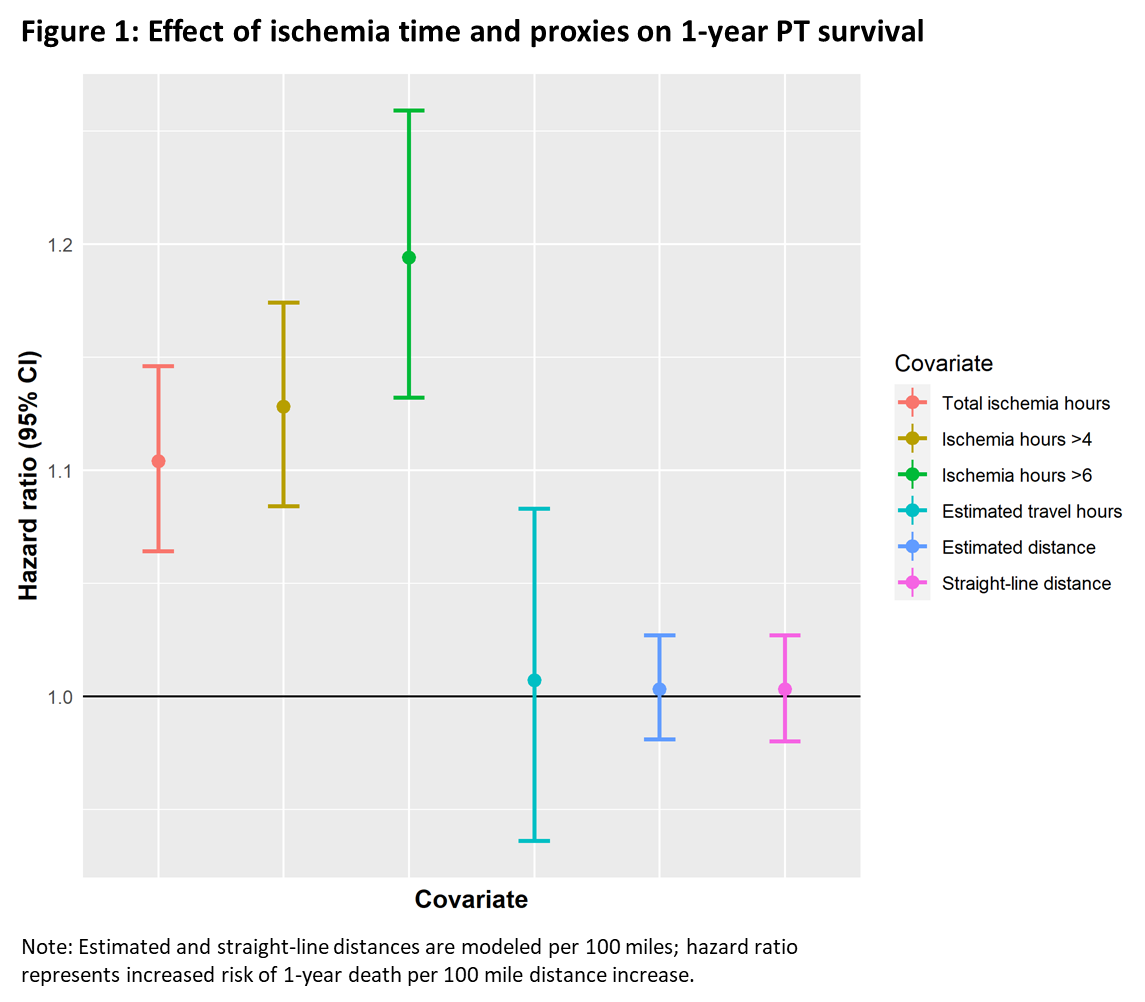Proxies of Ischemia Time Do Not Predict 1-Year Posttransplant Survival
1SRTR, Minneapolis, MN, 2Univ of Washington, Seattle, WA, 3Cleveland Clinic, Cleveland, OH, 4UNOS, Richmond, VA
Meeting: 2021 American Transplant Congress
Abstract number: 489
Keywords: Allocation, Ischemia, Lung transplantation, Survival
Topic: Administrative » Quality Assurance Process Improvement & Regulatory Issues
Session Information
Session Name: Quality Assurance Process Improvement & Regulatory Issues
Session Type: Poster Abstract
Session Date & Time: None. Available on demand.
Location: Virtual
*Purpose: A barrier to broader distribution of donor organs is a concern that increased donor-to-recipient (DtR) distances could increase ischemia times and compromise posttransplant (PT) survival. Some experts have recommended using DtR travel distance or time as proxies for ischemia time in a PT survival component of a continuous allocation score.
*Methods: We estimated DtR travel time and distance for lung transplant recipients from January 1, 2015 to December 31, 2018, using a Google application programming interface. We fit 6 Cox proportional hazards models to estimate the effects of ischemia time and its proxies (distance and time) on 1-year PT survival. Each model included the same donor and recipient factors, plus one of the following: ischemia time, ischemia time splines with knots at 4 or 6 hours, travel time, travel distance, or straight-line distance. We computed the correlation of ischemia time with its linear proxies.
*Results: Ischemia time was a significant predictor of PT survival, but none of its proxies were. Risk of PT death increased 10% for each increased hour of ischemia time. Linear splines resulted in 13% and 19% increases in risk of PT death for each additional hour of ischemia time above 4 and 6 hours, respectively. These estimates were significant at the P<0.0001 level. Hazard ratios for the three proxies were no different from 1 (Figure). While the proxies were significantly correlated with ischemia time (P<0.0001), the percent of variability explained (the square of the correlation coefficient) ranged from 17.0% for straight-line distance to 19.4% for travel hours. Thus, over 80% of the variability in ischemia time was due to factors other than travel. Clinicians theorized that travel and operating room (OR) logistics, OR complications, difficult donors, and complicated recipients contribute to ischemia time.
*Conclusions: Ischemia time was correlated with DtR travel time and distance but not strongly enough to predict outcomes. Non-travel factors may explain the relationship between ischemia time and PT survival.
To cite this abstract in AMA style:
Skeans M, Wey A, Lease E, Lehr C, Alcorn J, Goff R, Stewart D, Valapour M. Proxies of Ischemia Time Do Not Predict 1-Year Posttransplant Survival [abstract]. Am J Transplant. 2021; 21 (suppl 3). https://atcmeetingabstracts.com/abstract/proxies-of-ischemia-time-do-not-predict-1-year-posttransplant-survival/. Accessed December 23, 2025.« Back to 2021 American Transplant Congress

